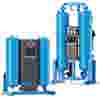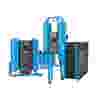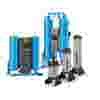REACH OUT TO US
Hankison compressed air dryers are renowned throughout the industry for delivering exceptional levels of energy-efficiency and reliability. With a wide range of available capacities and options tailored to customers’ specific needs, they are an essential element of any compressed air system.

Refrigerated Compressed Air Dryers

Desiccant Compressed Air Dryers

Membrane Compressed Air Dryers
What is a Compressed Air Dryer?
Compressed air dryers are vital in numerous industries for removing moisture from compressed air, a process crucial for the efficient and durable operation of the main compressor unit as well as all compressed air-dependent equipment.
An air dryer is a device specifically built to remove water from compressed air. Compressing air heats it up and draws in water vapor, leading to high humidity levels. As this air cools, the vapor turns into water, which can damage the system.
Moisture removal is critical because water can not only lead to the costly reduction of the compressor efficiency and increased risk of its failure. It can also rust tanks and pipes, weaken other related systems, and strip oils from tools.
It can mix with grease, affect blasting operations, and ruin paintwork, to name just a few potential risks. In freezing conditions, it can also lead to failures in piping systems and crucial components like brake systems.
With these risks in mind, virtually every application that uses compressed air also requires an air dryer to safeguard the process. Incorporating the right compressed air dryer into the system translates to considerable long-term savings for the end user. Selecting the appropriate air dryer depends on the air compressor’s needs and its use. Considerations include the maximum air pressure, the volume of air processed, and the overall costs – which cover the initial purchase, energy use, and ongoing maintenance.

When choosing a compressed air dryer, it’s crucial to look beyond the purchase price. Long-term costs such as application requirements, energy consumption, maintenance, and the risk of costly disruptions resulting from insufficient air quality should all be factored into the decision. A comprehensive evaluation of these expenses will lead to a dryer choice that best fits your and your customers’ operational and financial needs. Hankison’s team of experienced compressed air treatment experts can help you select the right equipment for your needs.
Hankison offers a broad range of the highest-quality compressed air drying solutions designed for specific applications and water vapor levels. By employing energy-saving technologies, they help you and your customers optimize the performance of the whole compressed air system, as well as all other equipment connected to it, including pneumatic tools, and thus significantly reduce the compressed air costs. Our portfolio comprises various compressed air dryer types such as:

Refrigerated Air Dryers
Refrigerated air dryers work by cooling the air to low temperatures, typically between 35°F to 50°F (1.7°C to 10°C). At these temperatures, the moisture in the air condenses into liquid water, which can then be removed from the system. This process is similar to how a home refrigerator or air conditioning system operates. Hankison’s refrigerated air dryers can handle air flows from 12 m³/h to 23,000 m³/h, which makes them suitable for a wide variety of industrial uses. These dryers havepower requirements ranging from 0.12 kW to 36.32 kWand include high-pressure models. Both cycling refrigerated air dryers and non-cycling options are available to suit your specific needs.

Desiccant Air Dryers
Desiccant air dryers use a hygroscopic material (desiccant) to adsorb and remove moisture from compressed air. As air flows through a bed of desiccant, moisture is trapped by the desiccant material. These dryers typically operate in twin-tower configurations where one tower dries the air while the other regenerates (releases absorbed moisture using heat or a purge air flow). Hankison’s desiccant air dryers are able to drive moisture levels to a pressuredew point of up to -70° Cand handle anyflow from 8 m3/h to 13,000 m3/h. These dryers are highly customizable and can be adapted to meet your unique medium, flow rate, operating pressure, and inlet air temperature needs. Both heatless and heated dryer models are on offer.

Membrane Air Dryers
Membrane air dryers use a specially engineered membrane that selectively permits water vapor to pass through it, separating it from the compressed air. The dry air continues through the system, while the water vapor is vented out. Hankison’s membrane air dryers target broad flow rate spectrums from 2.6 m³/h to 112.8 m³/h (HMD Series) and from 2.4 m³/h to 240.0 m³/h (HMM Series). Thanks to their compact design, quiet operation, and no use of refrigerants or desiccant materials, the dryers are an excellent choice for a wide array of applications, including highly sensitive ones.
Apart from compressed air dryers, Hankison’s offering also features a broad selection of air filters and other accessories such as condensate drains, air-liquid bypass valves, and oil-water separators. Hankison experts offer dryer sizing and configuration support to help you improve the efficiency of your compressed air system.

Hankison Compressed Air Dryers – Key Benefits
Hankison’s compressed air drying solutions provide you with a number of key advantages that enable you to optimize your mission-critical compressed air applications. These include:
- Consistent dew point control ensures constantly clean air even if your compressed air demand varies.
- Superior cost-efficiency guaranteed by the use of energy-saving technologies resulting in lower operational costs.
- High reliability ensured by our durable dryer designs and translating into minimal maintenance needs.
- Unrivaled flexibility and adaptability allowed for by the availability of numerous configuration options to match your exact application needs.
- Regulatory compliance, with ISO Class 1-5 options being available for industries that demand the highest-quality compressed air.
Compressed Air Dryer Applications
Compressed air dryers are essential in numerous industries, providing the dry air needed for countless industrial processes. In manufacturing, dry compressed air is crucial to prevent defects and ensure consistent product quality – a must in precision-dependent sectors.
In the automotive industry, compressed air powers tools, aids in painting, and runs assembly lines. Dry air is vital here to avoid equipment malfunctions and achieve perfect paint jobs. In food and beverage production, compressed air is key for packaging and bottling, where air dryers play a critical role in upholding cleanliness and preventing contamination.
Pharmaceutical manufacturing requires ultra-clean air to protect drug quality and production spaces, making refrigerated dryers a common choice for effective moisture removal.
In harsher conditions, such as hazardous areas or remote sites, deliquescent dryers are the go-to, useful in places like landfills or in wood and asphalt production. Compressed air dryers also prevent mold in healthcare, ensure food processing safety, contribute to textile manufacturing, and even keep ice rinks smooth.
Compressed Air Dryers Technology
Hankison is at the forefront of innovation in the compressed air dryer industry. Our R&D center is constantly working on improving our products and enhancing the value they provide to your business and, in extension, to your customers. Our dedication to excellence led us to incorporate numerous unique design solutions and energy-saving features that make our products stand out. Learn more about our technologies on our Technologies page.

